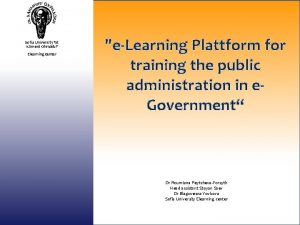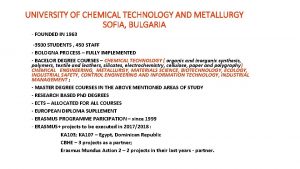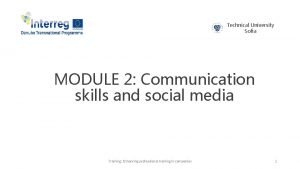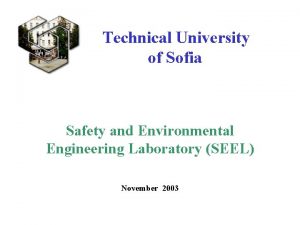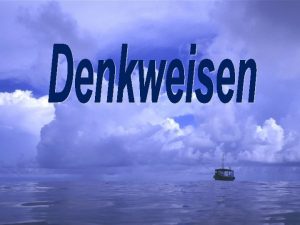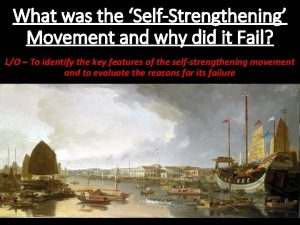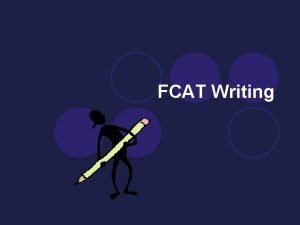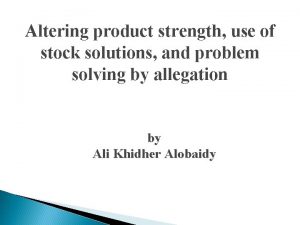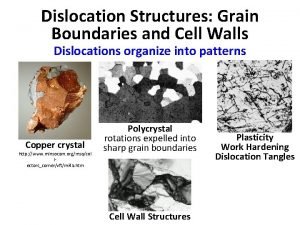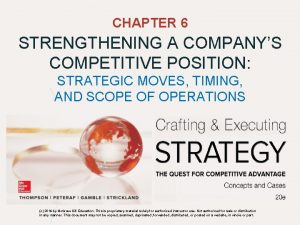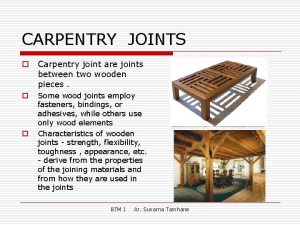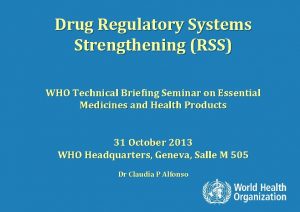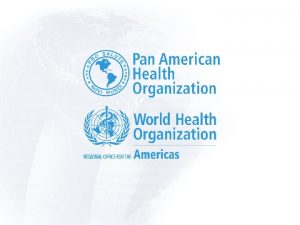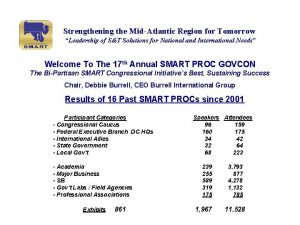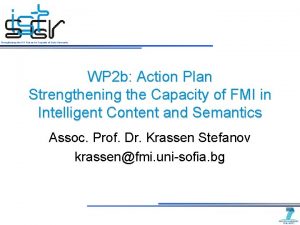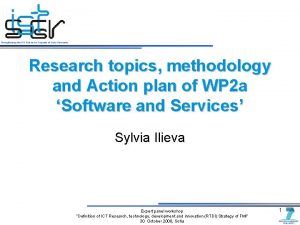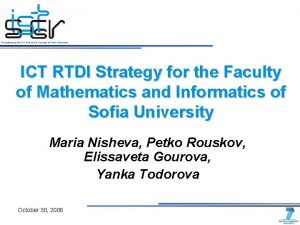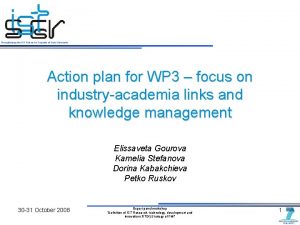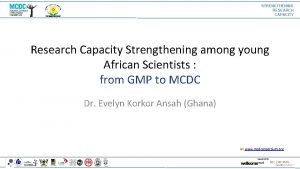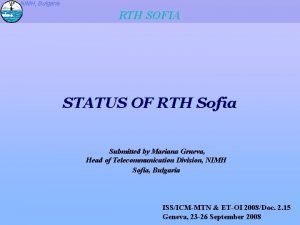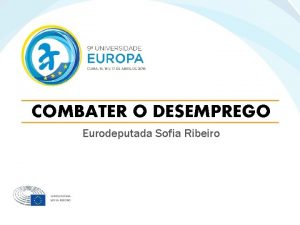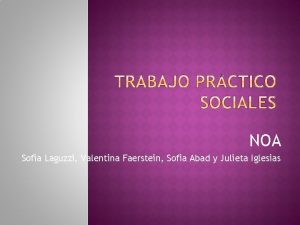Strengthening the IST Research Capacity of Sofia University




















- Slides: 20

Strengthening the IST Research Capacity of Sofia University Building scenarios for FMI RTDI Strategy and Action Plan Elissaveta Gourova 30 -31 October 2008 Expert panel workshop “Definition of ICT Research, technology, development and innovation (RTDI) Strategy of FMI” 1

Main topics Strengthening the IST Research Capacity of Sofia University • Purpose of building scenarios • Approach for building scenarios • Main steps • Key drivers • Follow-up activities 30 -31 October 2008 Expert panel workshop “Definition of ICT Research, technology, development and innovation (RTDI) Strategy of FMI” 2

Purpose of building scenarios Strengthening the IST Research Capacity of Sofia University • A scenario is an “imaginative story" illustrating visions of possible future or aspects of possible future. • Scenarios are similar to simulations of some possible futures. They offer a non-linear and dynamic way of thinking, require ability to deal with complexity, to consider multiple variables simultaneously, and with ‘different interpretation’ over time. • Scenarios are used as a tool for decision-making, mainly to highlight the discontinuities from the present and to reveal the choices available and their potential consequences. 30 -31 October 2008 Expert panel workshop “Definition of ICT Research, technology, development and innovation (RTDI) Strategy of FMI” 3

Benefits for the organization Strengthening the IST Research Capacity of Sofia University • Development of strategy and policy of an organisation • Stimulate critical thinking, intuition and creativity, challenge assumptions – within the organisation • Thinking “outside in” – big, external forces / drivers • Creating common language and understanding across scientific disciplines, units, etc. • Organisational alignment to long-term vision • Develop group of people with ability to think strategically 30 -31 October 2008 Expert panel workshop “Definition of ICT Research, technology, development and innovation (RTDI) Strategy of FMI” 4

Scenarios as an Exploratory Method Strengthening the IST Research Capacity of Sofia University desirable/ undesirable scenarios Alternative futures as a result from the multiple pathways possible Based on state-of-the-art, present trends and possible events/decisions, what we could expect to happen in the future? WHAT IF…? realistic scenarios If we do this, what will happen? . . . 30 -31 October 2008 Expert panel workshop “Definition of ICT Research, technology, development and innovation (RTDI) Strategy of FMI” 5

Strategic framework Strengthening the IST Research Capacity of Sofia University 30 -31 October 2008 Expert panel workshop “Definition of ICT Research, technology, development and innovation (RTDI) Strategy of FMI” 6

Approach for building scenarios Strengthening the IST Research Capacity of Sofia University Step 1: Identify the focal issues – start 'from the inside out‘ using interviews, questionnaires, other studies • mission, core challenges, staff assumptions, etc. • Step 2: Key forces in the micro environment - those that have a direct influence on the university (desk research, etc. ) • sector trends • specific regulations for HE and RTD • new technologies in education Step 3: Driving forces (macro environment) – broader and possibly global with impact on university (based on environmental scanning) • • • Society Technology Economy Ecology Policy 30 -31 October 2008 Expert panel workshop “Definition of ICT Research, technology, development and innovation (RTDI) Strategy of FMI” 7

Environments of an Educational Organization Strengthening the IST Research Capacity of Sofia University 30 -31 October 2008 Expert panel workshop “Definition of ICT Research, technology, development and innovation (RTDI) Strategy of FMI” 8

Strengthening the IST Research Capacity of Sofia University Approach for building scenarios Step 4: Rank key factors/driving forces by importance and uncertainty • • • Lifelong Learning Diversity/ Disappear Degrees delivered by restricted number of institutions ICT developments RTD policy Bologna process Industrial demand Migration processes Demographic changes Step 5: Selecting scenario logics 30 -31 October 2008 Open & Lifelong Network Degrees delivered by a large range of institutions Enterpre neurial Traditional Free market Initial tertiary education source: OECD scenarios Expert panel workshop “Definition of ICT Research, technology, development and innovation (RTDI) Strategy of FMI” 9

Approach for building scenarios Strengthening the IST Research Capacity of Sofia University • Step 6: Fleshing out the scenarios – details of scenarios according macro and micro drivers • Plausibility: A scenario must be plausible. This means that it must fall within the limits of what might conceivably happen. • Consistency: A scenario must be internally consistent. This means that the combination of logics in a scenario must not have any built-in inconsistency that could undermine the credibility of the scenario. • Differentiation: Scenarios should be structurally different, meaning that they should not be so close to one another that they become simply variations of a base case. • Decision-making utility: each scenario, and all scenarios if they constitute a set, should contribute specific insights into the future that will lead to the decision focus that was selected. 30 -31 October 2008 Expert panel workshop “Definition of ICT Research, technology, development and innovation (RTDI) Strategy of FMI” 10

Follow-up activities Strengthening the IST Research Capacity of Sofia University • Step 7: Implications of scenarios • high risk, feasibility, vulnerability for the organisation, etc. • Step 8: Selection of leading indicators and signposts • for future monitoring and control • • Step 9: Feed the scenarios back to those consulted Step 10: Discuss the strategic options Step 11: Agree the implementation plan Step 12: Publicise the scenarios 30 -31 October 2008 Expert panel workshop “Definition of ICT Research, technology, development and innovation (RTDI) Strategy of FMI” 11

Strengthening the IST Research Capacity of Sofia University Example: OECD Scenarios for higher education (1) Features of changes with strong impact on the university: • Change in mission and participation at university – from ‘elite’ audience towards mass education. • Greater autonomy for universities and entry of new private providers. • Third, large differences among universities across the world, but changes in a more globalised and liberalised world. • Impact of ICT on universities - new avenues for teaching and research in higher education. 30 -31 October 2008 Expert panel workshop “Definition of ICT Research, technology, development and innovation (RTDI) Strategy of FMI” 12

Strengthening the IST Research Capacity of Sofia University Example: OECD Scenarios for higher education (2) Main driving forces at global level: • Demographic and Participation Trends • decline in the number of young people • increasing demand for post-secondary education by older students • international students mobility • Governance and Funding • • • public university largely publicly funded decrease of public funding due to other public priorities trend for mixed funding shift towards autonomy and entrepreneurship strong demand for accountability, efficiency, effectiveness, transparency, responsiveness and forward vision in public governance 30 -31 October 2008 Expert panel workshop “Definition of ICT Research, technology, development and innovation (RTDI) Strategy of FMI” 13

Strengthening the IST Research Capacity of Sofia University Example: OECD Scenarios for higher education (3) Main driving forces at global level: • Building the Knowledge Economy • increasing share of GDP of knowledge-intensive activities • demand for innovation activities, strong research sector and lifelong learning • ICT usage in university teaching, research and management • higher communication and collaboration opportunities • increase of industry-academia partnerships • IPR greater importance • New Actors in Higher Education • • emergence of corporate universities, consortia, virtual universities expanding demand for professional certification and corporate training diminish borders between different types of education institutions emergence of various partnerships 30 -31 October 2008 Expert panel workshop “Definition of ICT Research, technology, development and innovation (RTDI) Strategy of FMI” 14

Usage of six variables for construction of scenarios: 1. the type of population covered by tertiary education, as well as correlated variables; 2. the nature of funding (predominantly public, mixed, predominantly private); 3. the integration of missions offered; 4. the international dimension of the system; 5. the homogeneity of status of faculty and institutions; 6. the degree of take-up of technology (e-learning, e-research). OECD approach Strengthening the IST Research Capacity of Sofia University 30 -31 October 2008 Expert panel workshop “Definition of ICT Research, technology, development and innovation (RTDI) Strategy of FMI” 15

Scenarios approach (1) Strengthening the IST Research Capacity of Sofia University Contextual environment • • • What shape will society have, what role will individuals and communities play, and what attitudes will they exert towards research and education? What educational system and climate will exist - lifelong learning, e-education, learning-bydoing? Which economic climate will shape 2020: employment, type of labor, age, labor force, position in the world? How would pedagogy, organisation of curricula and provision be affected by the changes in number, age and origin of the student population? How would the traditional missions of universities evolve? Technology developments • • What kind of technology will we be using in 2020? How will stakeholders interact with this technology in order to provide/consume education and research services and to participate in innovation processes? For which services and/or intentions of participation will the stakeholders use these technologies for interaction with universities in 2020? Will the university carry out the main bulk of research or will revenue generating research be mainly undertaken in the R & D division of companies? Will the university provide skilled workers with the retraining that will become increasingly necessary in a knowledge economy? Will ICTs lead to a change in the provision of research and teaching? How will intellectual property rights regimes facilitate or hinder those developments? Expert panel workshop 30 -31 October 2008 “Definition of ICT Research, technology, development and innovation (RTDI) Strategy of FMI” 16

Scenarios approach (2) Strengthening the IST Research Capacity of Sofia University Universities and their stakeholders • Which roles will universities perform at EC, national and local level? Which policies and laws will be key? Which relationships with citizens and business will exist? • What kinds of services will be provided by universities and consumed by customers in 2020? • Which modes of stakeholder participation in the education processes will exist: Which stakeholders? Who will participate and how? What impact and power of decision-making will certain types of stakeholders have? • Which roles and activities will state, NGOs, interest groups and industry play in education and research service provisioning and participation? • Will the university become more clearly demand driven, leading to changes in its internal management and teaching practices as well as a shift in its core missions? • Increased use of cost-effective technologies and entry to foreign education markets are two responses of the university that are currently being experimented with in some countries: will these activities gain even more ground in the future? 30 -31 October 2008 Expert panel workshop “Definition of ICT Research, technology, development and innovation (RTDI) Strategy of FMI” 17

Scenarios approach (3) Strengthening the IST Research Capacity of Sofia University Driving Forces (10 minutes) • Review the list of driving forces provided in your group. Add to it if your group wishes. • Discuss the forces that you think will be the most important to institutions like yours. • Select the two key forces driving change in institutions like yours over the next five to seven years. You may either come to consensus or use voting to narrow the list. Record these driving forces on the table master. These forces are the basis of your scenario building. Develop Scenarios (20 minutes) • Create four scenarios using the two driving forces you selected. Develop two to three descriptive phrases for each scenario. • Select one scenario as most likely to occur for institutions like yours 30 -31 October 2008 Expert panel workshop “Definition of ICT Research, technology, development and innovation (RTDI) Strategy of FMI” 18

Strengthening the IST Research Capacity of Sofia University • • • Scenarios approach: driving forces Ageing of the workforce Biotechnology Declines in enrollment Declining student retention Energy Environment/climate Global economy Human rights/values/quality life/political issues Increased competition Increased government regulation 30 -31 October 2008 • Knowledge systems/information technology • Lack of skilled workers • Multiple options/uncertainty • Need to demonstrate outcomes • Population changes • Pressure to reduce tuition • Rising consumer expectations • Rising student expectations • Space exploration • Technological change • Terrorism Expert panel workshop “Definition of ICT Research, technology, development and innovation (RTDI) Strategy of FMI” 19

Strengthening the IST Research Capacity of Sofia University Thank you for your attention! for contacts: elis@fmi. uni-sofia. bg 30 -31 October 2008 Expert panel workshop “Definition of ICT Research, technology, development and innovation (RTDI) Strategy of FMI” 20
 Elearn uni sofia
Elearn uni sofia University of chemical technology and metallurgy
University of chemical technology and metallurgy Technical university sofia
Technical university sofia Technical university of sofia
Technical university of sofia Design capacity and effective capacity examples
Design capacity and effective capacity examples Winter kommt flocken fallen nieder
Winter kommt flocken fallen nieder Es war eine mutter
Es war eine mutter Ich habe heute klassendienst
Ich habe heute klassendienst Es ist herbst bunte blätter fliegen
Es ist herbst bunte blätter fliegen Zu glauben ist schwer. nichts zu glauben ist unmöglich
Zu glauben ist schwer. nichts zu glauben ist unmöglich Why did the qing’s self strengthening movement fail?
Why did the qing’s self strengthening movement fail? Brainpop strengthening sentences answer key
Brainpop strengthening sentences answer key Cold working formula
Cold working formula Strengthening or concentration preparations can be made by:
Strengthening or concentration preparations can be made by: Grain boundary strengthening
Grain boundary strengthening Strengthening a company's competitive position
Strengthening a company's competitive position Which lengthening joint has better tension resistance?
Which lengthening joint has better tension resistance? 6 pillars of health system strengthening
6 pillars of health system strengthening Regulatory system strengthening
Regulatory system strengthening Regulatory system strengthening
Regulatory system strengthening Strengthening the mid-atlantic region for tomorrow
Strengthening the mid-atlantic region for tomorrow
